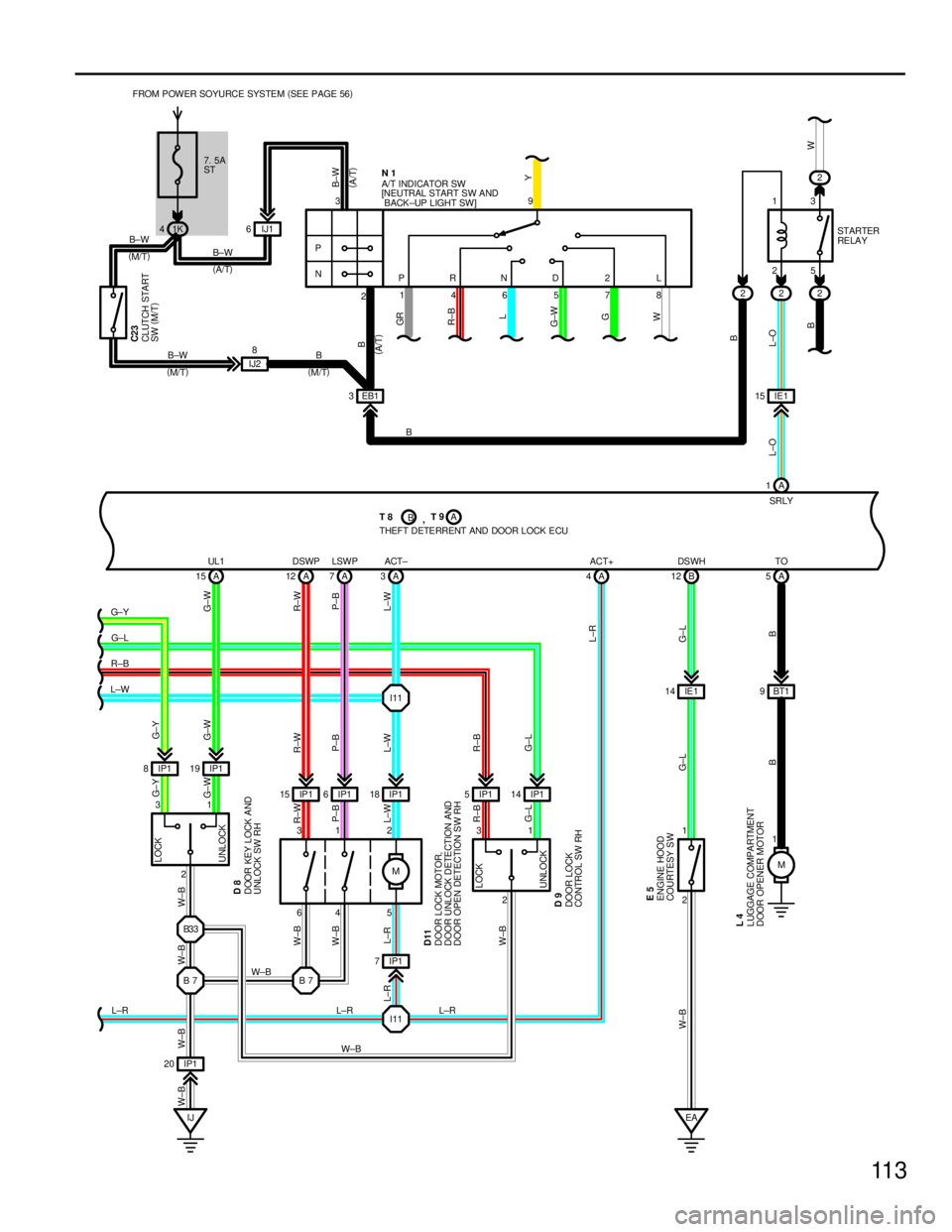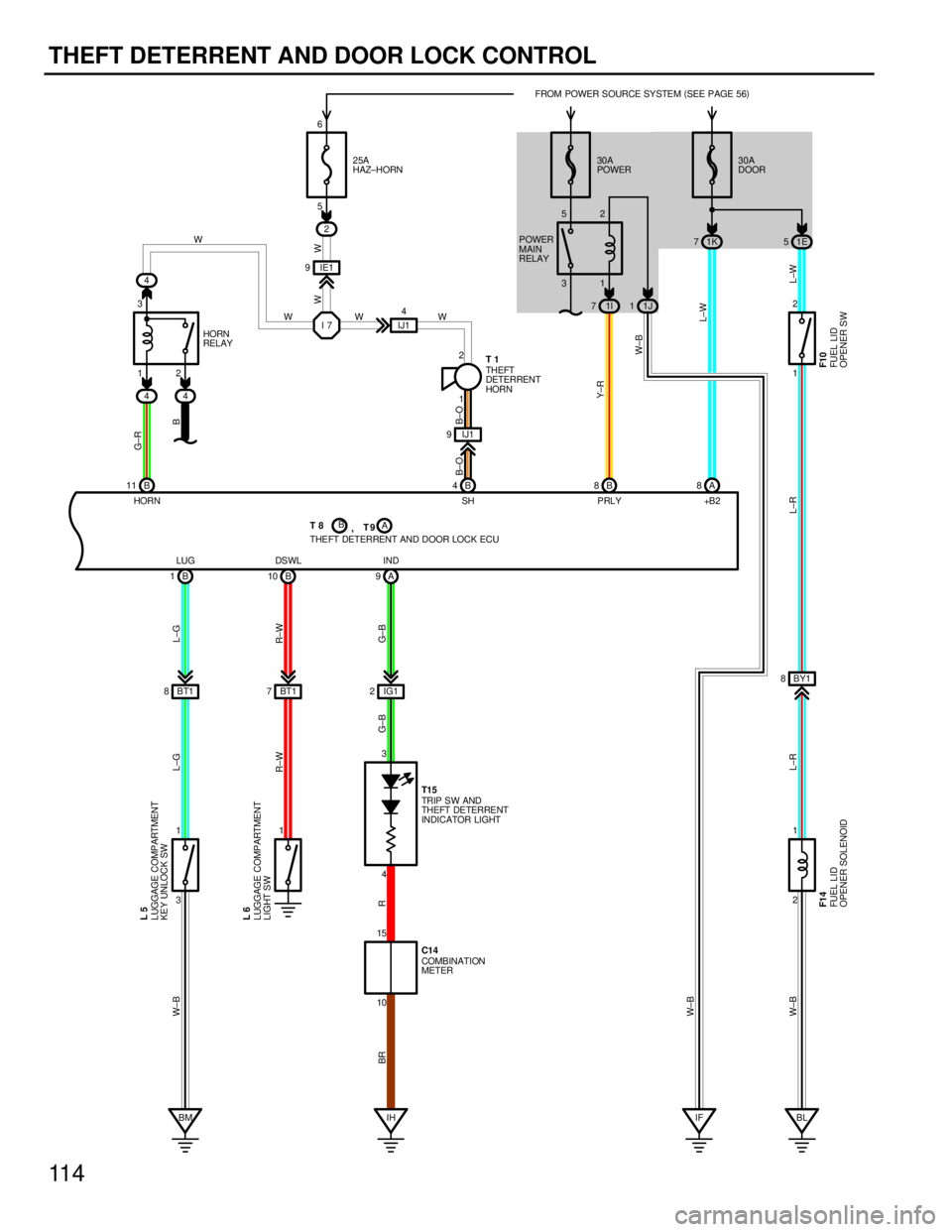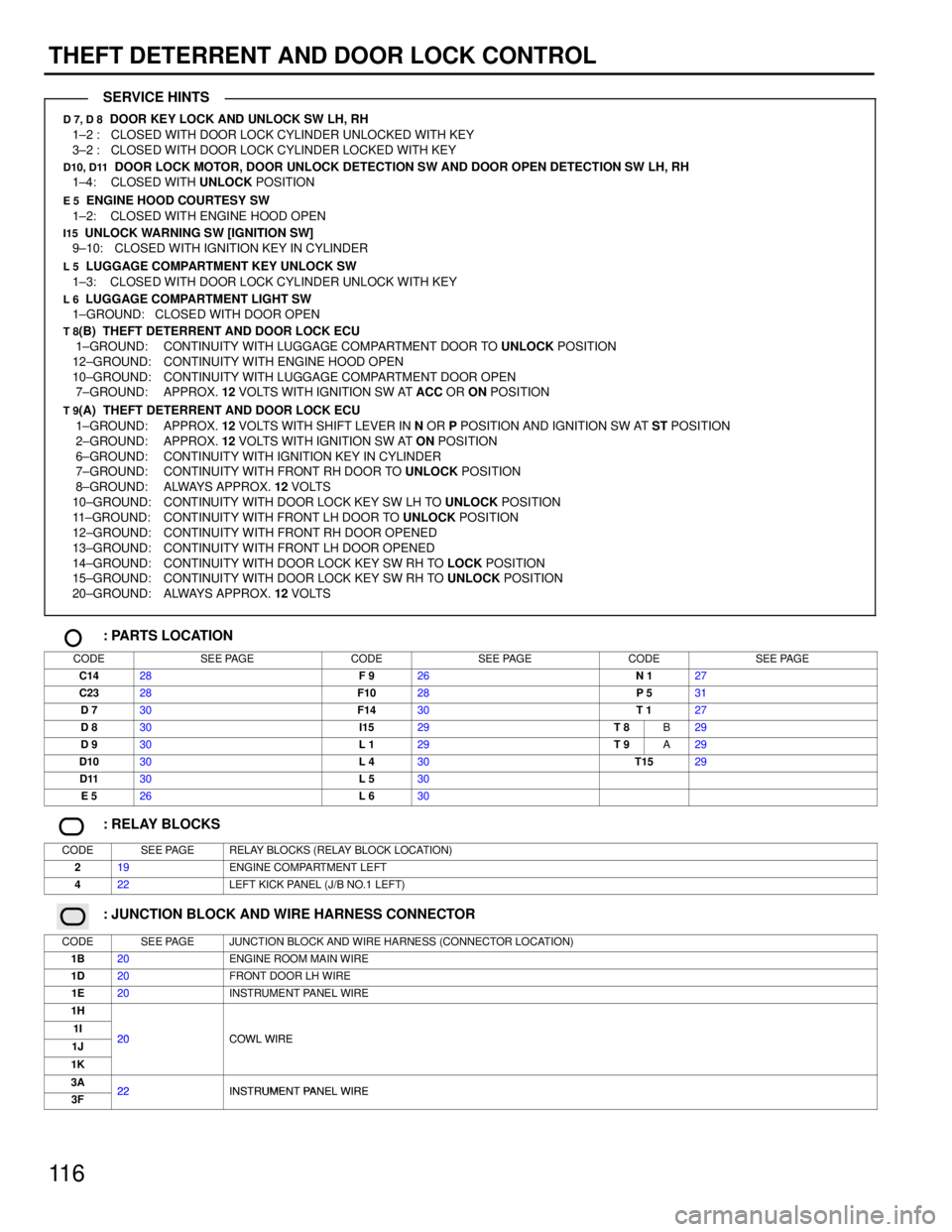LEXUS SC400 1991 Service Repair Manual
Manufacturer: LEXUS, Model Year: 1991, Model line: SC400, Model: LEXUS SC400 1991Pages: 4087, PDF Size: 75.75 MB
Page 4071 of 4087

11 3
M
64 5 31 2
1K
4
2
2
2 2
I11
B7 B7 I11
EB1
3 IE1
15
IP1
20
IP1
8IP1 19
IP 1
15 IP1 6IP1 18 IP1 5IP114 IE 1
14 BT1 9
IP1
7
A
15 UL1
A
12 DSWP
A
7 LSW P
A
3 ACT±
A
4 ACT+
B
12 DS WH
A
5 TOA
1
SRLY25 13
2
31
2
31
IJ EA
2 1
PRND 2 L
146578 9
GR
R±B
L
G±W G
W
A/T INDICATOR SW
[NEUTRAL START SW AND BACK±UP LIGHT SW]
N1
2
3
FROM POWER SOYURCE SYSTEM
(
SEE PAGE 56 )
7. 5A
ST
P
N STARTER
RE LA Y
THEFT DETERRENT AND DOOR LOCK ECU
LOCK
UNLOCK
LOCK
UNLOCK
DOOR KEY LOCK AND
UNLOCK SW RH
DOOR LOCK MOTOR,
DOOR UNLOCK DETE CTION AND
DOOR OPEN DETECTION SW RH DOOR LOCK
CONTROL SW RHENGINE HOOD
COURTESY SW
LUGGAGE COMPARTMENT
DOOR OPENER MOTOR
G± Y G±L
R±B
L±W
L±R W±B
L±R L±R B
Y
W
B
L±O B
B
L±O
B
G±L L±R
G±L B
W±B W±B
L±R
W±B W±B W±B
W±B W±B
L±R R±BG±L
L±W
P±B
R±W G±W
G±Y G±Y
G±W
R±W P±B
L±W
R±BG±L L±W
P±B
R±W
G±W
L4 E5
D9
D11 D8
T8
,T
9
B A
M
1
IJ1
6
B±W
( A/T )
IJ28
B±W B
( M/T )(
M/T)
B±W
( A/T )
B±W
( M/T )
CLUTCH STA RT
SW (
M/T )
C23
( A/T )
B3 3
W±BW±B
WhereEverybodyKnowsYourName
Page 4072 of 4087

11 4
THEFT DETERRENT AND DOOR LOCK CONTROL
2
5
1K
71E 5
44 1I
71J 1
3 11 IE1
9
2
1
BM IF BL
BT1
8BT1 7IG1 2IJ1
4
IJ1
9
B
11
HORN B
4
SH B
8
PRLY A
8
+B 2
B
1 LUG
B
10 DS WL
A
9 IND
4
I72
12
1
4
3
3
15
10 1 2
BY1
8
IH FROM POWER SOURCE SYSTEM
(
SEE PAGE 56 )
25A
HAZ±HORN 30A
POWER30A
DOOR
POWER
MAIN
RELAY
W
WW W
G±R
WW
B±O
B±O
Y±RW±B
L±W
L±W
L±R
L±R
W±B W±B G±B
R±W L±G
L±G
R±W G±B
R
BR W±B
TRIP S W AND
THEFT DETERRENT
INDICATOR LIGHT
COMB INATION
METER
FUEL L I D
OPENER SOLENOID
FUEL LI D
OPENER SW
THEFT
DETERRENT
HORN
HORN
RELAY
LUGGAGE COMPARTMENT
LIGHT SW LUGGAGE COMPARTMENT
KEYUNLOCKSW
THEFT DETERRENT AND DOOR LOCK ECU T8
,T9 T1
F1 0
F1 4
T1 5
C14
L6 L5
B
A
B
6
52
31
WhereEverybodyKnowsYourName
Page 4073 of 4087

11 5
CURRENT ALWAYS FLOWS TO TERMINAL (A)8 OF THE DOOR LOCK ECU THROUGH THE DOOR FUSE, AND TO TERMINAL (A)20
THROUGH THE DOME FUSE.
WHEN THE IGNITION SW IS TURNED ON, THE CURRENT FLOWING THROUGH THE ECU±IG FUSE " TERMINAL (A)2 OF THE ECU "
TERMINAL (B)8 FLOWS THROUGH THE COIL SIDE OF THE POWER MAIN RELAY TO GROUND, CAUSING THE RELAY TO OPERATE.
THE CURRENT FLOWING THROUGH THE POWER FUSE FLOWS TO THE DOOR LOCK CONTROL SW LH, CAUSING THE INDICATOR
LIGHT TO LIGHT UP.
1. MANUAL LOCK OPERATION
WHEN THE DOOR CONTROL SW OR KEY SW ARE PUSHED TO LOCK POSITION, A LOCK SIGNAL IS INPUT TO TERMINAL (A)17, (A)14
(FOR KEY SW) OF THE DOOR LOCK ECU AND CAUSES THE ECU TO FUNCTION. CURRENT FLOWS FROM TERMINAL (A)8 OF THE
ECU " TERMINAL (A)4 " TERMINAL 5 OF THE DOOR LOCK MOTORS " TERMINAL 2 " TERMINAL (A)3 OF THE ECU " TERMINAL
(A)16 " TO GROUND AND THE DOOR LOCK MOTOR CAUSES THE DOOR TO LOCK.
2. MANUAL UNLOCK OPERATION
WHEN THE DOOR LOCK CONTROL SW OR KEY ARE PUSHED TO UNLOCK POSITION, AN UNLOCK SIGNAL IS INPUT TO TERMINAL
(A)18, (A)10 (FOR KEY SW LH) OR (A)15 (FOR KEY SW RH) OF THE DOOR LOCK ECU AND CAUSES THE ECU TO FUNCTION.
CURRENT FLOWS FROM TERMINAL (A)8 OF THE ECU " TERMINAL (A)3 " TERMINAL 2 OF THE DOOR LOCK MOTORS " TERMINAL
5 " TERMINAL (A)4 OF THE ECU "TERMINAL (A)16 " TO GROUND AND THE DOOR LOCK MOTOR CAUSES THE DOOR TO
UNLOCK.
WHEN UNLOCK OPERATION OCCURS USING THE LH DOOR KEY SW, PERFORMING THE UNLOCK OPERATION ONCE UNLOCKS
ONLY THE DRIVER'S DOOR. TO UNLOCK ALL THE OTHER DOORS TOGETHER, UNLOCK OPERATION MUST BE PERFORMED AGAIN
WITHIN 3 SECONDS OF THE FIRST OPERATION.
3. IGNITION KEY REMINDER OPERATION
* OPERATION OF DOOR LOCK BUTTON (OPERATION OF DOOR LOCK MOTORS)
WHEN THE IGNITION KEY IS IN THE CYLINDER (UNLOCK WARNING SW ON) AND THE DOOR IS OPENED AND LOCKED USING
DOOR LOCK BUTTON (DOOR LOCK MOTOR), THE DOOR IS LOCKED ONCE BUT EACH DOOR IS UNLOCKED SOON BY THE
OPERATION OF THE ECU. AS A RESULT OF ECU ACTIVATION, THE CURRENT FLOWS FROM TERMINAL (A)8 OF THE ECU "
TERMINAL (A)3 " TERMINAL 2 OF THE DOOR LOCK MOTORS " TERMINAL 5 " TERMINAL (A)4 OF THE ECU " TERMINAL (A)16
" TO GROUND AND CAUSES ALL THE DOORS TO UNLOCK.
THE SAME APPLIES TO OPERATION OF THE DOOR LOCK CONTROL SW AND DOOR LOCK KEY SW.
* KEY LESS LOCK OPERATION
WHEN THE IGNITION KEY IS STILL INSERTED IN THE CYLINDER (UNLOCK WARNING SW ON), THE DOOR IS OPEN AND UNLOCK
OPERATION IS PREVENTED BY KEEPING THE DOOR LOCK BUTTON PRESSED TO THE LOCK SIDE, THE DOOR IS KEPT IN THE
LOCK CONDITION. IF THE DOOR IS THEN CLOSED, A SIGNAL IS INPUT TO THE ECU FROM THE DOOR COURTESY SW. THIS
ACTIVATES THE ECU AND EACH DOOR IS UNLOCKED.
SYSTEM OUTLINE
WhereEverybodyKnowsYourName
Page 4074 of 4087

11 6
THEFT DETERRENT AND DOOR LOCK CONTROL
D 7, D 8 DOOR KEY LOCK AND UNLOCK SW LH, RH
1±2 : CLOSED WITH DOOR LOCK CYLINDER UNLOCKED WITH KEY
3±2 : CLOSED WITH DOOR LOCK CYLINDER LOCKED WITH KEY
D10, D11 DOOR LOCK MOTOR, DOOR UNLOCK DETECTION SW AND DOOR OPEN DETECTION SW LH, RH
1±4: CLOSED WITH UNLOCK POSITION
E 5 ENGINE HOOD COURTESY SW
1±2: CLOSED WITH ENGINE HOOD OPEN
I15 UNLOCK WARNING SW [IGNITION SW]
9±10: CLOSED WITH IGNITION KEY IN CYLINDER
L 5 LUGGAGE COMPARTMENT KEY UNLOCK SW
1±3: CLOSED WITH DOOR LOCK CYLINDER UNLOCK WITH KEY
L 6 LUGGAGE COMPARTMENT LIGHT SW
1±GROUND: CLOSED WITH DOOR OPEN
T 8(B) THEFT DETERRENT AND DOOR LOCK ECU
1±GROUND: CONTINUITY WITH LUGGAGE COMPARTMENT DOOR TO UNLOCK POSITION
12±GROUND: CONTINUITY WITH ENGINE HOOD OPEN
10±GROUND: CONTINUITY WITH LUGGAGE COMPARTMENT DOOR OPEN
7±GROUND: APPROX. 12 VOLTS WITH IGNITION SW AT ACC OR ON POSITION
T 9(A) THEFT DETERRENT AND DOOR LOCK ECU
1±GROUND: APPROX. 12 VOLTS WITH SHIFT LEVER IN N OR P POSITION AND IGNITION SW AT ST POSITION
2±GROUND: APPROX. 12 VOLTS WITH IGNITION SW AT ON POSITION
6±GROUND: CONTINUITY WITH IGNITION KEY IN CYLINDER
7±GROUND: CONTINUITY WITH FRONT RH DOOR TO UNLOCK POSITION
8±GROUND: ALWAYS APPROX. 12 VOLTS
10±GROUND: CONTINUITY WITH DOOR LOCK KEY SW LH TO UNLOCK POSITION
11±GROUND: CONTINUITY WITH FRONT LH DOOR TO UNLOCK POSITION
12±GROUND: CONTINUITY WITH FRONT RH DOOR OPENED
13±GROUND: CONTINUITY WITH FRONT LH DOOR OPENED
14±GROUND: CONTINUITY WITH DOOR LOCK KEY SW RH TO LOCK POSITION
15±GROUND: CONTINUITY WITH DOOR LOCK KEY SW RH TO UNLOCK POSITION
20±GROUND: ALWAYS APPROX. 12 VOLTS
: PARTS LOCATION
CODESEE PAGECODESEE PAGECODESEE PAGE
C1428F 926N 127
C2328F1028P 531
D 730F1430T 127
D 830I1529T 8B29
D 930L 129T 9A29
D1030L 430T1529
D1130L 530
E 526L 630
: RELAY BLOCKS
CODESEE PAGERELAY BLOCKS (RELAY BLOCK LOCATION)
219ENGINE COMPARTMENT LEFT
422LEFT KICK PANEL (J/B NO.1 LEFT)
: JUNCTION BLOCK AND WIRE HARNESS CONNECTOR
CODESEE PAGEJUNCTION BLOCK AND WIRE HARNESS (CONNECTOR LOCATION)
1B20ENGINE ROOM MAIN WIRE
1D20FRONT DOOR LH WIRE
1E20INSTRUMENT PANEL WIRE
1H
1I20COWL WIRE1J20COWL WIRE
1K
3A22INSTRUMENT PANEL WIRE3F22INSTRUMENT PANEL WIRE
SERVICE HINTS
WhereEverybodyKnowsYourName
Page 4075 of 4087

11 7
: CONNECTOR JOINING WIRE HARNESS AND WIRE HARNESS
CODESEE PAGEJOINING WIRE HARNESS AND WIRE HARNESS (CONNECTOR LOCATION)
EB134ENGINE WIRE AND ENGINE ROOM MAIN WIRE (FRONT SIDE OF R/B NO.2)
IE136ENGINE ROOM MAIN WIRE AND COWL WIRE (R/B NO.4)
IF236FRONT DOOR LH WIRE AND COWL WIRE (LEFT KICK PANEL)
IG136INSTRUMENT PANEL WIRE AND COWL WIRE (R/B NO.5)
IJ136ENGINE WIRE AND COWL WIRE (RIGHT KICK PANEL)IJ236ENGINE WIRE AND COWL WIRE (RIGHT KICK PANEL)
IP138FRONT DOOR RH WIRE AND COWL WIRE (RIGHT KICK PANEL)
BT140FLOOR WIRE AND COWL WIRE (LEFT KICK PANEL)
BY140INSTRUMENT PANEL WIRE AND FLOOR NO.3 WIRE (RIGHT KICK PANEL)
: GROUND POINTS
CODESEE PAGEGROUND POINTS LOCATION
EA34FRONT SIDE OF RIGHT FENDER
IF36LEFT KICK PANEL
IH36UNDER THE ASHTRAY LH
IJ36RIGHT KICK PANEL
BL40UNDER THE CENTER PILLAR RH
BM40BACK PANEL CENTER
: SPLICE POINTS
CODESEE PAGEWIRE HARNESS WITH SPLICE POINTSCODESEE PAGEWIRE HARNESS WITH SPLICE POINTS
I 738COWL WIREB 740FRONT DOOR RH WIREI1138COWL WIREB3340FRONT DOOR RH WIRE
B 440FRONT DOOR LH WIRE
WhereEverybodyKnowsYourName
Page 4076 of 4087

10
TROUBLESHOOTING
VOLTAGE CHECK
(a) Establish conditions in which voltage is present at thecheck point.
Example: ± Ignition SW on
± Ignition SW and SW 1 on
± Ignition SW, SW 1 and Relay on (SW 2 off)
(b) Using a voltmeter, connect the negative lead to a good ground point or negative battery terminal, and the
positive lead to the connector or component terminal.
This check can be done with a test light instead of a
voltmeter.
CONTINUITY AND RESISTANCE CHECK
(a) Disconnect the battery terminal or wire so there is novoltage between the check points.
(b) Contact the two leads of an ohmmeter to each of the check points.
If the circuit has diodes, reverse the two leads and check
again.
When contacting the negative lead to the diode positive side
and the positive lead to the negative side, there should be
continuity.
When contacting the two leads in reverse, there should be no
continuity.
(c) Use the volt/ohmmeter with high impedance (10 k W/V
minimum) for troubleshooting of the electrical circuit.
WhereEverybodyKnowsYourName
Page 4077 of 4087

11
FINDING A SHORT CIRCUIT
(a) Remove the blown fuse and disconnect all loads of thefuse.
(b) Connect a test bulb in place of the fuse.
(c) Establish conditions in which the test bulb comes on.
Example: ± Ignition SW on
± Ignition SW and SW 1 on
± Ignition SW, SW 1 and Relay on (Connect theRelay) and SW 2 off (or Disconnect SW 2)
(d) Disconnect and reconnect the connectors while watching the test bulb.
The short lies between the connector where the test
bulb stays lit and the connector where the bulb goes
out.
(e) Find the exact location of the short by lightly shaking the problem wire along the body.
CAUTION:
(a) Do not open the cover or the case of the ECU unlessabsolutely necessary. (If the IC terminals are touched,
the IC may be destroyed by static electricity.)
(b) When replacing the internal mechanism (ECU part) of the digital meter, be careful that no part of your body or
clothing comes in contact with the terminals of leads
from the IC, etc. of the replacement part (spare part).
DISCONNECTION OF MALE AND FEMALE
CONNECTORS
To pull apart the connectors, pull on the connector itself, not the
wire harness.
HINT: Check to see what kind of connector you are disconnecting
before pulling apart.
WhereEverybodyKnowsYourName
Page 4078 of 4087

12
TROUBLESHOOTING
HOW TO REPLACE TERMINAL
(with terminal retainer or secondary locking
device)
1. PREPARE THE SPECIAL TOOLHINT: To remove the terminal from the connector, please construct and use the special tool or like object shown
on the left.
2. DISCONNECT CONNECTOR
3. DISENGAGE THE SECONDARY LOCKING DEVICE OR TERMINAL RETAINER
(a) Locking device must be disengaged before theterminal locking clip can be released and the terminal
removed from the connector.
(b) Use a special tool or the terminal pick to unlock the secondary locking device or terminal retainer.
NOTICE:
Do not remove the terminal retainer from connector
body.
For Non±Waterproof Type Connector
HINT: The needle insertion position varies according to the connector's shape (number of terminals
etc.), so check the position before inserting it.
ªCase 1º Raise the terminal retainer up to the temporary
lock position.
ªCase 2º Open the secondary locking device.
WhereEverybodyKnowsYourName
Page 4079 of 4087

13
For Waterproof Type Connector
HINT: Terminal retainer color is differentaccording to connector body.
Example:
Terminal Retainer
: Connector Body
Black or White : Gray
Black or White : Dark Gray
Gray or White : Black
ªCase 1º Type where terminal retainer is pulled up
to the temporary lock position (Pull Type).
Insert the special tool into the terminal
retainer access hole ( Mark) and pull the
terminal retainer up to the temporary lock
position.
HINT: The needle insertion position varies according to the connector's shape
(Number of terminals, etc.), so check the
position before inserting it.
ªCase 2º Type which cannot be pulled as far as
Power Lock
WhereEverybodyKnowsYourName
Page 4080 of 4087

14
TROUBLESHOOTING
Insert the tool straight into the access hole of terminal
retainer as shown.
Push the terminal retainer down to the temporary lock
position.
(c) Release the locking lug from terminal and pull theterminal out from rear.
4. INSTALL TERMINAL TO CONNECTOR (a) Insert the terminal.
HINT:
1. Make sure the terminal is positioned correctly.
2. Insert the terminal until the locking lug locks firmly.
3. Insert the terminal with terminal retainer in thetemporary lock position.
(b) Push the secondary locking device or terminal retainer into the full lock position.
5. CONNECT CONNECTOR
WhereEverybodyKnowsYourName